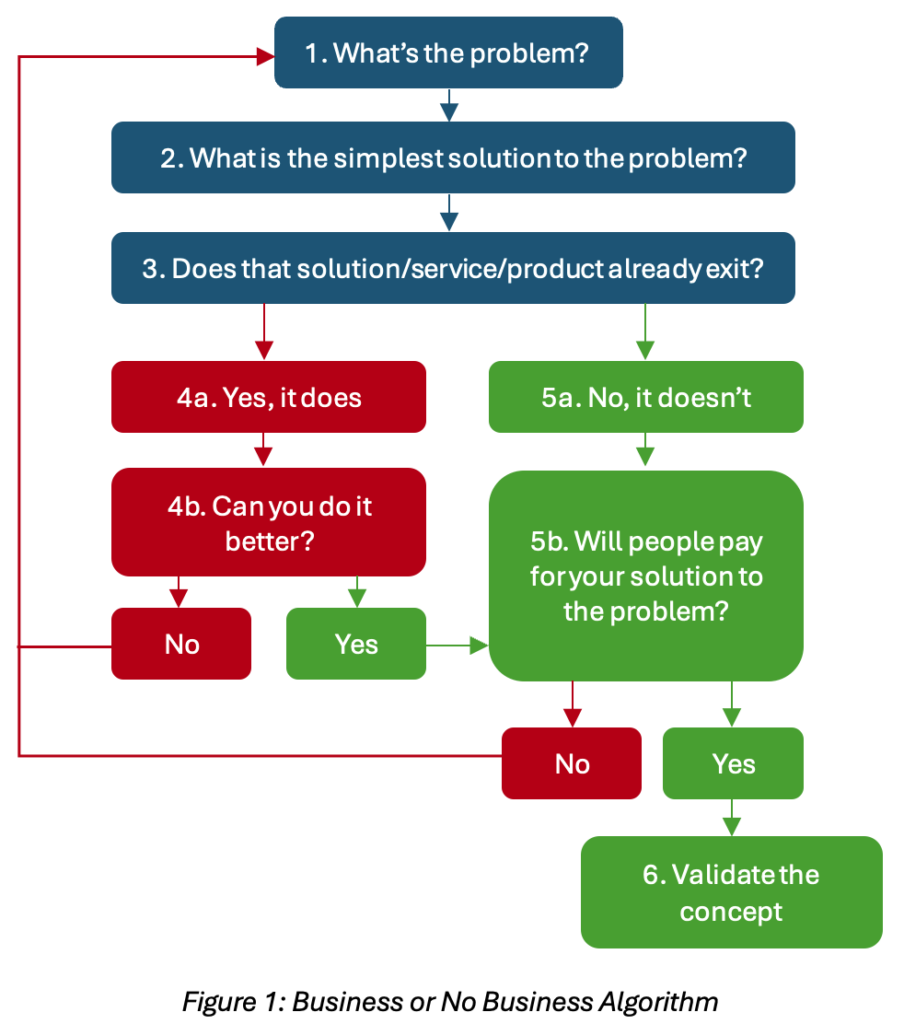- The Myth of the “Eureka” Moment
- Business or No Business Algorithm
- Step 1: Focus on Problems, Not Ideas
- Step 2: Create Fast, Simple Solutions
- Step 3-5: Know Your Competition Inside Out
- Step 6: Validate the Concept
- Take-Home Message: Stop Waiting, Start Experimenting
“I’d love to start a business, but I’ve no idea what I’d do!” – If you’ve ever said this, or heard someone else say it, then join my mailing list. Seriously, I’ll wait… Done? Great, let’s dive in.
The Myth of the “Eureka” Moment
One of the biggest reasons we hesitate to jump into entrepreneurship is the belief that we lack good business ideas. There’s a common misconception that we must wait for a “lightbulb moment,” a flash of inspiration that reveals the perfect idea. I’ve often found myself waiting for such moments. However, the truth is, great ideas rarely strike like lightning. Creativity and problem-solving require active engagement; we must immerse ourselves in a subject, absorb information, and consistently experiment with different angles.
In this post, inspired by the principles from Million Dollar Weekend by Noah Kagan (which encourages launching a profitable business in just 48 hours), I’ll show you how I have generated my ideas and started validating them quickly using my Business or No Business Algorithm shown below in Figure 1.

Step 1: Focus on Problems, Not Ideas
The best business ideas solve real-life problems. Start by noticing small issues around you: what are your daily frustrations, inefficiencies, or gaps in existing services or products? Once you identify a problem, ask yourself the following questions outlined in the Business or No Business Algorithm (Figure 1).
Turning this exercise into a daily habit will train your brain to generate business ideas quickly. Once you get the hang of it, apply the same process to problems in industries you care about or are knowledgeable in.
Tips:
- Write down 10 problems you encounter every day, no matter how small.
- Talk to people in your network about their frustrations, especially in areas where you have expertise.
Network and Collaborate
Sometimes, the best business ideas come from conversations with others. Surrounding yourself with entrepreneurial-minded individuals allows for the cross-pollination of ideas. Networking can introduce you to problems and industries you hadn’t previously considered.
Tip: Join online communities (such as this one – sign up for my mailing list for weekly updates and monthly virtual brainstorming meetings), attend industry events, or connect with mentors. Exposing yourself to different perspectives will help you spot opportunities you may have overlooked.
Step 2: Create Fast, Simple Solutions
Once you’ve identified a problem, brainstorm the simplest possible solution. The goal is to think small, testable, and quick. Your first solution doesn’t need to be perfect – it just needs to be functional enough to gather feedback from real customers.
Example: If the problem is difficulty organising personal schedules, a simple solution might be to create a basic calendar platform or offer a time-management service.
Step 3-5: Know Your Competition Inside Out
Brilliant – you’ve identified a problem and crafted an effective solution. The excitement is high, and you’re ready to hit the ground running. But then you remember that someone has beaten you to the idea, and that person is called Mark Zuckerberg. 🤦♂️ …back to the drawing board.
Another common reason we shy away from entrepreneurship is the belief that every good idea has already been taken. If that were true, new businesses wouldn’t keep emerging. The key is market research – we need to know exactly what our competitors are offering, and ask ourselves: can I offer a better or more unique solution? What is my unique selling point (USP)? [Article Coming Soon]
Tips:
- Thoroughly research your competitors. Look at their strengths, weaknesses, pricing models, and customer feedback.
- Identify unmet needs or frustrations among customers that you could address more effectively.
- Use tools like Google Trends, SEMrush, and social media platforms to gain valuable market insights.
Knowing your competition ensures you enter the market fully informed and understand how to position yourself, saving you time and effort later on.
Step 6: Validate the Concept
Once you’ve crafted a simple solution, it’s time to validate it with real users. Validation is key to business development: you need to find out if people are willing to pay for your solution, and there are quick and effective ways to do this:
- Create a landing page or send out surveys.
- Ask potential customers if they’d pay for your product/service, how much they’d pay, and what features they’d expect.
- Use platforms like Google Forms for surveys or Mailchimp to gather early interest and feedback.
Example: Dropbox famously started with just a demo video to validate customer demand before fully building their platform. Within days, they had hundreds of sign-ups, confirming the market need.
Evidence-Based Insight: Research from Harvard Business School suggests that testing ideas quickly through Minimum Viable Products (MVPs) significantly increases the chances of business success, as early feedback allows for timely adjustments and improvements.
Take-Home Messages: Stop Waiting, Start Acting
- You don’t need to wait for a lightning bolt of inspiration. Business ideas are everywhere—you just need to train yourself to see them.
- Focus on solving everyday problems, and use the “Business or No Business” algorithm to evaluate ideas quickly.
- Don’t spend months perfecting your idea. Set a 48-hour deadline to generate and validate it.
- Remember, it’s not about having the perfect idea from the start—it’s about taking the first step and evolving as you go.
- Validating your business concept is just the beginning.
Join my journey and subscribe to my mailing list for more insights to discover the world of entrepreneurship together!





Leave a Reply